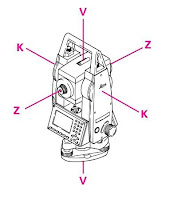ldeally , the total station should meet the following requirements:
a) Line of sight ZZ perpen- dicular to tilting axis KK
b) Tilting axis KK perpen- dicular to vertical axis VV
c) Vertical axis VV strictly vertical
d) Vertical- circle reading precisely zero at the zenith
lf these conditions are not met, the following terms are used to describe the particular errors:
Line-of-sight error, or colli- mation error c (deviation from the right angle bet- ween the line of sight and the tilting axis)
Tilting-axis error a (devia- tion from the right angle between the tilting axis and the vertical axis Vertical-axis tilt (angle
between plumb line and vertical axis).
The effects of these three errors on the measurement of horizontal angles increase with the height difference between the target points Taking measurements in both telescope faces eliminates line-of-sight errors and tilting-axis errors. The line-of-sight errors (and, for highly- nrecise total stations, also the tilting-axis error, which is generally very small) can also be determined and stored. These errors are then taken into consideration automatically whenever an angle is measured, and then it is possible to take mea- surements practically free of error even using just one telescope face. The deter- mination of these errors, and their storage, are described in detail in the appropriate user manual Vertical- axis tilt does not rate as being an instrument error; it arises because the instrument has not been adequately levelled up, and measuring in both telescope faces cannot eliminate it. lts influence on the measurement of the horizontal and vertical angles is automatically corrected by means of a two-axis compensator.
d) Height-index error i ( the angle between the zenith direction and the zero reading of the vertical circle, i.e. the vertical- circle reading when using a horizontal line of sight). is not 100 gon + i.
By measuring in both faces and then averaging. the index error is eliminated; it can also be determined and stored.
Note:
The instrument errors change with temperature, as a result of vivration, and after long periods of transport. lf you want to measure in just one face, then immediately before the measurements you must determine the instrument errors and store them.









0 تعليقات
اذا كنت خارج البلاد ومحتاج معلومة مهمة ومش لاقيها ! ممكن دلوقتي تكتب نوع المعلومة الي انت محتاجها وراح نجاوبك بيها علي طول من خلال اضافتها للموقع او من خلال الرد عليك من خلال بريدك الالكتروني او الاتصال بك مباشرة
(أطلب الشرح الي انت محتاجة ولا تتردد)
فريق منارة العلوم يساعدك علي مدار 24 ساعة